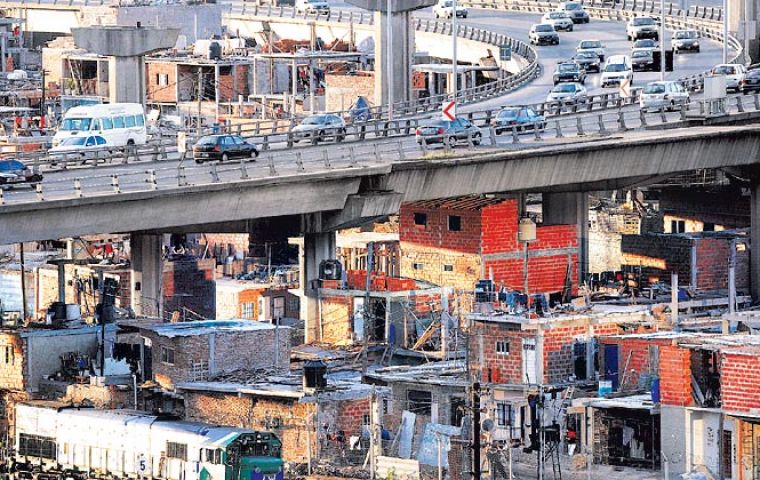MercoPress. South Atlantic News Agency
Half a million families live in Buenos Aires slums and keep expanding vertically and horizontally
 One of the 864 ‘villa miserias’ that surround Buenos Aires city
One of the 864 ‘villa miserias’ that surround Buenos Aires city Over half a million families live in 864 slums and irregular settlements in metropolitan Buenos Aires surrounding Argentina’s capital. Of this number 66% have over fifteen years since founded and in 65% of them expansion either horizontally or vertically continues.
The report is the result of a census from a NGO “A roof for my country” (UTPMP) and covers the largest metropolitan concentration of Argentina with a quarter of the country’s population and over 50% of GDP.
“We define ‘villa miseria’ (‘misery slums’) as highly crowded concentrations in which there are no roads, but passages, with vertical growth and far more difficult to urbanize.
Settlements on the other hand respect the layout, certain display of roads, plots and open spaces for leisure and some services”, said Agustin Algorta head of the UTPMP Social Department.
While in the first ring of metropolitan Buenos Aires the ratio of slums to irregular settlements is 55% to 44%, in the following rings the irregular settlements predominate.
The periphery rings of slums and irregular settlements surrounding the city of Buenos Aires first flourished in the 1930s and 1940s along railways, but 66% of them have just over 15 years and 65% of them continue to expand.
Following the meltdown of the Argentine economy in 2001/02 and the strong and sustained recovery since then, in the last decade (2002/2011) the number of new settlements has increased by 16.7% and the population by 55% in those already established, points out the report.
Regarding the origin of the informal urbanizations population, most belong to migratory groups (68.1%), ‘from rural areas to the city’ and in 83% of those surveyed, there are migrants from neighbouring countries, mainly Paraguay and Bolivia.
However “as families develop new roots, they tend to remain in the same slum or settlement helping to keep it expanding, points out Algorta.
Only 17.5% of new generations moves to some housing complex outside their original living place and does not necessarily mean a change to a formal urbanization.
“The persistence of slums and irregular settlements in metropolitan Buenos Aires is but evidence of the great deficit regarding access to basic services and adequate urban infrastructure for different sectors of the community. The scarce provision of plots for residential developments with services’ infrastructure together with an insufficient housing policy contributes to the continuing informal urbanization process”, points Mari Laura Raffo who was responsible for the field work.
According to the UTPMP census only in 16% of informal urbanizations have housing programs been implemented by government and most of them in 2009 and 2010.
Most slums and settlements have been constructed on fiscal land, 52.4%; in usurped private land 35%. As to their location, 35.3% along dry streams or rivers; 33.6% close to high traffic lanes and 21.9% next to garbage dumps.
An overwhelming majority (85%) have no sewage which is partially compensated with some form of precarious sceptic facilities (54%). In 80% of them there is no pluvial drainage which means repeated swamping and the presence of stagnant waters which help the development of diseases and parasites.
Regarding public utilities, 83.4% have no access to the gas network and appeal to carafes (much dearer than the subsidized network gas). Minimum percentages have access to running water and power, although in this last case there is a lot of illegal ‘hanging’ to the urban grid.
A majority (84.3%) of the periphery population living in these conditions has a primary school in a ten blocks radius, but that percentage drops to 57.6% when it comes to high school, which has a huge influence in the high percentage of drop outs and repeat.
Finally 67.7% have access to primary medical attention in clinics in the ten block radius, regarding hospitals the percentage drops dramatically to 7%.




Top Comments
Disclaimer & comment rules-

-

-

Read all commentscome on cristina, bring it on baby, because you're doing a great job :) Argentina avanza! hacia el abismo.
Oct 07th, 2011 - 10:36 pm 0that picture is not of Argentina...
Oct 08th, 2011 - 01:21 am 0that picture was taken in Buenos Aires, I can tell
Oct 08th, 2011 - 04:35 am 0Commenting for this story is now closed.
If you have a Facebook account, become a fan and comment on our Facebook Page!